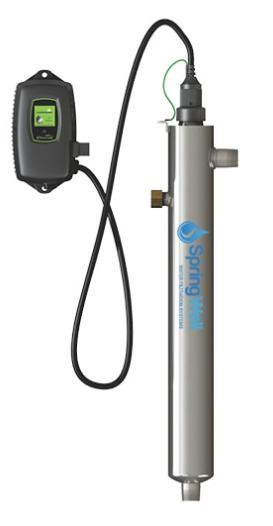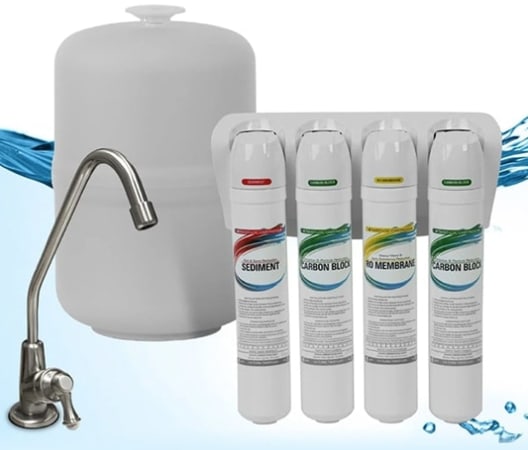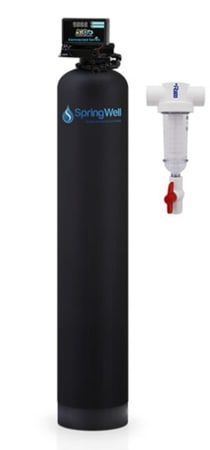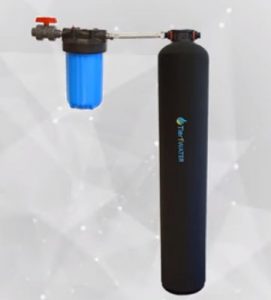Minnesota Department of Health states that the main reason your well water smells or tastes like rotten eggs is hydrogen sulfide gas (H2S). H2S can be found naturally, produced by sulfur bacteria in groundwater, well, plumbing system, or water heaters.
The fix for eliminating the rotten egg smell is based on its cause. This article discusses the causes and solutions in detail.
Reasons why Water Smells like Rotten Egg
Rotten Egg Smell in Hot Water Taps
Many private well owners report rotten egg smell in hot water. The reason is bacterial growth on anode rod and water tank.
Don’t miss: How to Remove Iron, Manganese, Sulfur & Coliform from Well Water
Rotten Egg Smell in Cold Water Taps
Rotten egg smell in cold water hints that sulfur bacteria is present in your well, plumbing system, pressure tank, or faucets.
Check this by drawing water in a large bucket from your pressure tank and smell it. A rotten egg smell will confirm that bacteria are present in your well. If water doesn’t smell, check water in the same way from every water treatment unit. This will help you identify the smell source.
Solutions to get Rid of Rotten Eggs Smell
Smell in Hot Water – The rotten egg smell from hot water indicates bacterial growth in your water heater. There are two ways you can deal with it. First, you must service your water heater. Second, use an anode rod specifically designed for well water to reduce bacterial growth and eliminate rotten egg smell.
Cold Water Smell Problem – Cold water rotten egg smell can be fixed with various methods. The right method may depend on how frequently rotten egg smell comes back and the concentration of sulfur bacteria in well water.
You must get your well water tested for bacteria before installing/modifying your home treatment system.
Shock Chlorinate your Water Well
Shock chlorination is a proven and reliable method to eliminate bacteria and viruses from well water. Private well owners must chlorinate their wells every 2-4 years to ensure that it is free from pathogenic growth.
Shock chlorination is also the cheapest solution to kill bacteria in water. One drawback is that it makes water unusable for a few days but it gives excellent results.
Shock chlorination also kills bacteria in plumbing pipes, appliances, and faucets.
Install a Chlorinator and a Carbon Filter
A chlorinator is only recommended for private wells with recurring bacterial contamination. The system works by adding chlorine in a measured amount according to the volume of water passing through it. A chlorinator is often installed with a carbon filter to remove chlorine smell and taste.
SpringWell’s Chemical Injection System is recommended for private well owners facing recurring bacterial contamination. It kills bacteria and oxidizes iron, sulfur, and manganese in water.
UV filters and RO filters
The rotten egg smell usually makes water unusable. However, you must be 100% sure that sulfur bacteria are not entering your drinking water. There are two effective ways to remove sulfur bacteria from drinking water. You can install a UV purifier or a RO filter to purify your drinking water.
These systems are available as standalone models or as a part of a multi-stage filtration system.
SpringWell’s UV Water Purification System

This standalone system kills up to 99.9% of bacteria, viruses, protozoa, or other pathogens in well water. It is a costly unit compared to other UV purifiers on the market, but its high price is justified by its features.
The unit comes with an electronic control head that indicates the time left to change the UV bulb and when your water is unsafe for consumption. It is easy to install and is covered with a lifetime warranty.
SpringWell’s Reverse Osmosis Water Filter

The filter removes all smells, tastes, and impurities up to 99.9 percent. The system consists of a sediment filter, two carbon filters, and an RO membrane. It comes with a pressurized tank for storing filtered water.
This is an under sink filter with a 75-gallon per day filtration capacity. You can install it to remove TDS from the water.
Iron Removal Filter
Iron filters are suggested for wells with low to moderate hydrogen sulfide, iron, and manganese concentration. The filter works by oxidizing these contaminants which are then trapped by a filtration media. The filtration media is backwashed periodically and replaced every few months.
Recommended Filter: SpringWell’s Whole House Well Water Filter System

It is one of the best whole house water filters for well water. It can remove hydrogen sulfide up to 8 PPM, iron up to 7 PPM, and manganese up to 1 PPM.
It is an advanced filter that lets you control it through your smartphone. Moreover, it has a lifetime warranty, lasting 10-20 years without any problems.
The unit comes with a sediment filter, control head, and all tools required for DIY installation.
Aeration Removal Method
Aerating the well water reduces hydrogen sulfide to acceptable levels and eliminates the rotten egg smell. It is an expensive solution and adds another machine to your well water system to take care of.
Use Ozone Gas
You can also use ozone gas to get rid of rotten egg smell from your well water. It is a costly setup and mostly installed by municipalities.
Check the Water Softener

An unmaintained water softener can harbor bacteria. If nothing works above, the bacteria may be present in your water softener. Get it service to resolve the problem.
Health Problems because of Hydrogen Sulfide Gas
- Eye, nose, and throat irritation if concentration is low.
- Respiratory tract problems that can get severe for asthma patients.
- Prolonged exposure can lead to inflammation and the severity of the symptoms.
- The situation can be worse if someone is exposed to a high concentration of this gas for an extended duration, and it can result in shock, convulsion, coma, and unconsciousness.
FAQ
What is the chlorine bleach water ratio for disinfection?
For a well containing 100 feet of water and an 8-inch diameter, 1 gallon of household bleach with 5.25% chlorine is suggested. Do not use scented bleach or bleach with cleaners other than chlorine. If you have a larger well, expect to use more chlorine.
Which is the best carbon filter to get rid of the chlorine smell after disinfection?
AO Smith’s whole house water filter system is an excellent choice for removing chlorine smell from water. It can filter 600,000 gallons of water and will last for 5-6 years for an average American family.
Conclusion: What’s the Best Solution?
We have listed several possible solutions to get rid of the rotten egg smell from your well water. The best solution is to use chlorine and a carbon filter. If you cannot afford a chlorine injector, you can add some chlorine bleach in your well.
Water filters are recommended when chlorination doesn’t solve the problem.
